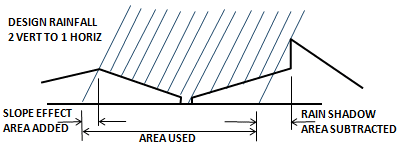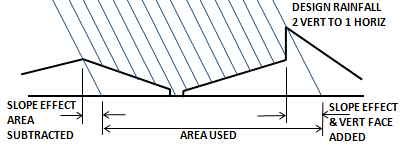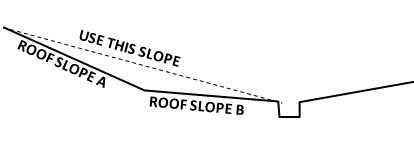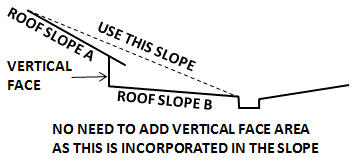BOX GUTTER WITH OUTLET NOT AT THE END, AND WITH VERTICAL OVERFLOW
Allowing for rain shadow effects
Method of Calculating Catchment Areas
Rainfall calculated from all directions and worst case adopted.


Unit Conversions
Roof Slopes for combined Roofs


Note:
For the purpose of calculation the catchment has been divided into 4 quadrants. Left hand side (LHS), and right hand side (RHS), Upper and Lower. It doesn't matter which is which, as long as all data is consistent within the quadrant. That is, don't put a vertical face, or roof slope belonging to quadrant A, into another quadrant.
It is not necessary to use all quadrants, or use vertical faces. However by definition, to have a sump somewhere along the gutter implies that there will be flow approaching the sump from two sides. LHS & RHS. The side with the maximum flow is used to size the box gutter. The total flow is used to size the sump and overflow.
However entering only one quadrant will still work. The sump however will be a bit unusual, being at the end with a vertical overflow. But stranger things have happened.
This free online box gutter calculator will calculate the size of box gutters, and sumps with a vertical/high capacity overflow, in accordance with the Australian Plumbing Code AS/NZS 3500.3 .2003 Part 3 Storm Water Drainage.
But it can be used for elsewhere in the world if you know the design rainfall intensity requirements for your area.
For locations using to the International Plumbing code, or the Uniform Plumbing Code, as in the USA, the rainfall intensity required relates to a storm frequency of 100 years, with duration of one hour.
Using an upper and lower quadrant is only necessary for calculating rain shadow effects. If it is a very flat roof, without major vertical faces, the rain shadow effect will be minimal. Therefore the total catchment of upper and lower can be combined into just one side.
The calculator is only suitable for draining to a sump with a vertical overflow.
If draining to a rainwater head at the end of a box gutter use this calculator. or incorporating vertical faces use this.
If draining to a sump with a side overflow, somewhere along the box gutter use this calculator.
Method used
The method used is based on the flow chart Fig 3.1 AS/NZS 3500.3:2003
Downpipe and sump depth from Fig I4, with minimum sump depth 150mm. This may be deepened if loc is less than 60mm.
Sump depths greater than 250 are extrapolated from Fig I4. So if you wish to be within the limits of the graph, a larger downpipe should be used.
Height of overflow weir above the bottom of the box gutter (loc) from Fig I6a.
Note, it is possible in a wide box gutter for the depth to be shallower than for box gutters with a free outfall. (due to differences in the freeboard requirements) In this instance the deepest box gutter is required, and used in the program.
Trial Box Gutter Width
The minimum width allowed for domestic projects is 200mm. For commercial projects the minimum allowable width is 300mm. However any width can be entered. Experiment with this figure to get the depth of box gutter you require.
Vertical faces
Enter the full vertical face area. The program does the 50% reduction in area as required by the Code.
Box Gutter Slope
Slope should be within the range of 1:40 to 1:200.
Maximum Flow
The code maximum flow is limited to 16 L/s, because this was the limit of their experimentation.
The code suggests that the catchment areas must reduced if necessary to achieve this.
However this calculator has no limit. The formulas used are standard hydraulic formulas, weir, orifice, channel etc with parameters and methods adjusted to give results consistent with the Plumbing Code. So there is no reason to believe that the formulas will cease to work above 16 L/s. However designing above 16L/s is outside the "deemed to satisfy" provisions of the code, but can be done by "Competent persons" so please satisfy yourself that this calculator is suitable for this.
Sizes
The depth shown, of the box gutter, is the depth at the upstream end.
The theoretical down pipe diameter is shown for reference purposes only. This is a good size for the required flow. Choose an available size (or any other size) and enter that for the calculation of the sump. Smaller sizes result in a deeper sump and larger sizes result in a shallower sump.
The Minimum sump depth is 150mm. The calculator will not go below this.
The code Sump length is 600mm. However if you choose to go above 16L/s, the downpipe may get larger than 150 dia. If this is the case the sump length will increase to accommodate the downpipe.
The Overflow diameter is the same as the downpipe diameter.
More notes on overflowing and fail safe design
The total flow, catchment areas used, and worst wind direction will appear after you do a calculation.
Maximum allowable length (Code requirement for expansion reasons)
Copyright Ken Sutherland 2024Rainfall calculated from all directions and worst case adopted.


Unit Conversions
Conversions (Rounded)
Roof Slopes for combined Roofs


Note:
For the purpose of calculation the catchment has been divided into 4 quadrants. Left hand side (LHS), and right hand side (RHS), Upper and Lower. It doesn't matter which is which, as long as all data is consistent within the quadrant. That is, don't put a vertical face, or roof slope belonging to quadrant A, into another quadrant.
It is not necessary to use all quadrants, or use vertical faces. However by definition, to have a sump somewhere along the gutter implies that there will be flow approaching the sump from two sides. LHS & RHS. The side with the maximum flow is used to size the box gutter. The total flow is used to size the sump and overflow.
However entering only one quadrant will still work. The sump however will be a bit unusual, being at the end with a vertical overflow. But stranger things have happened.
This free online box gutter calculator will calculate the size of box gutters, and sumps with a vertical/high capacity overflow, in accordance with the Australian Plumbing Code AS/NZS 3500.3 .2003 Part 3 Storm Water Drainage.
But it can be used for elsewhere in the world if you know the design rainfall intensity requirements for your area.
For locations using to the International Plumbing code, or the Uniform Plumbing Code, as in the USA, the rainfall intensity required relates to a storm frequency of 100 years, with duration of one hour.
Using an upper and lower quadrant is only necessary for calculating rain shadow effects. If it is a very flat roof, without major vertical faces, the rain shadow effect will be minimal. Therefore the total catchment of upper and lower can be combined into just one side.
The calculator is only suitable for draining to a sump with a vertical overflow.
If draining to a rainwater head at the end of a box gutter use this calculator. or incorporating vertical faces use this.
If draining to a sump with a side overflow, somewhere along the box gutter use this calculator.
Method used
The method used is based on the flow chart Fig 3.1 AS/NZS 3500.3:2003
Downpipe and sump depth from Fig I4, with minimum sump depth 150mm. This may be deepened if loc is less than 60mm.
Sump depths greater than 250 are extrapolated from Fig I4. So if you wish to be within the limits of the graph, a larger downpipe should be used.
Height of overflow weir above the bottom of the box gutter (loc) from Fig I6a.
Note, it is possible in a wide box gutter for the depth to be shallower than for box gutters with a free outfall. (due to differences in the freeboard requirements) In this instance the deepest box gutter is required, and used in the program.
Trial Box Gutter Width
The minimum width allowed for domestic projects is 200mm. For commercial projects the minimum allowable width is 300mm. However any width can be entered. Experiment with this figure to get the depth of box gutter you require.
Vertical faces
Enter the full vertical face area. The program does the 50% reduction in area as required by the Code.
Box Gutter Slope
Slope should be within the range of 1:40 to 1:200.
Maximum Flow
The code maximum flow is limited to 16 L/s, because this was the limit of their experimentation.
The code suggests that the catchment areas must reduced if necessary to achieve this.
However this calculator has no limit. The formulas used are standard hydraulic formulas, weir, orifice, channel etc with parameters and methods adjusted to give results consistent with the Plumbing Code. So there is no reason to believe that the formulas will cease to work above 16 L/s. However designing above 16L/s is outside the "deemed to satisfy" provisions of the code, but can be done by "Competent persons" so please satisfy yourself that this calculator is suitable for this.
Sizes
The depth shown, of the box gutter, is the depth at the upstream end.
The theoretical down pipe diameter is shown for reference purposes only. This is a good size for the required flow. Choose an available size (or any other size) and enter that for the calculation of the sump. Smaller sizes result in a deeper sump and larger sizes result in a shallower sump.
The Minimum sump depth is 150mm. The calculator will not go below this.
The code Sump length is 600mm. However if you choose to go above 16L/s, the downpipe may get larger than 150 dia. If this is the case the sump length will increase to accommodate the downpipe.
The Overflow diameter is the same as the downpipe diameter.
More notes on overflowing and fail safe design
The total flow, catchment areas used, and worst wind direction will appear after you do a calculation.
Maximum allowable length (Code requirement for expansion reasons)
| Material | Base Metal Thickness (mm) | Max Length (metres) | Minimum expansion space (mm) |
|---|---|---|---|
| Aluminum | 0.90 | 12 | 50 |
| Copper | 0.60 | 9 | 50 |
| Copper | 0.80 | 15 | 50 |
| Copper | 1.0 | 26 | 50 |
| Steel Colorbond Zincalume | 0.55 | 20 | 50 |
| Steel | 0.75 | 25 | 50 |
| Stainless Steel | 0.55 | 20 | 50 |
| PVC | - | 10 | 30 |
| Zinc | 0.80 | 10 | 50 |
If you find that the programs save you time or money, please feel free to donate to a worthy cause (me).